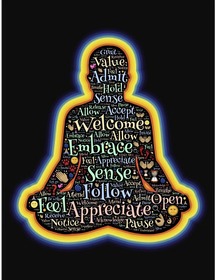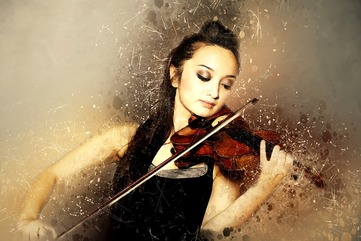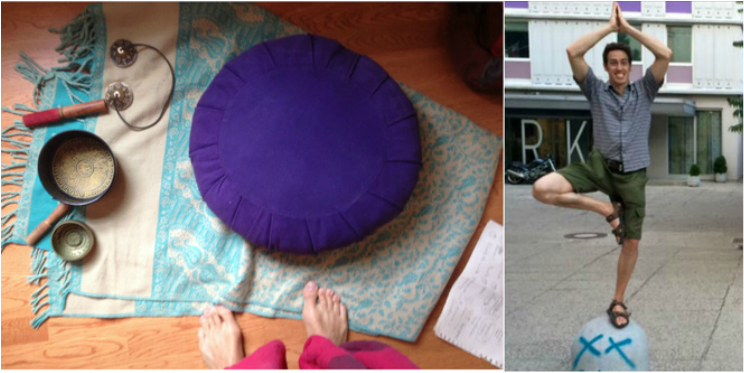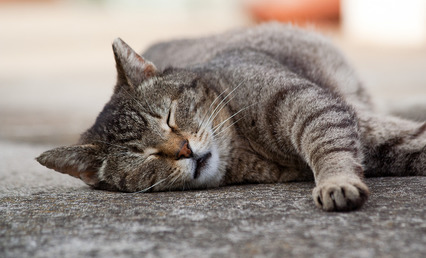|
I’ve been asked by a few people what happens in a mindfulness session. Most people now understand what meditation is - they’ve seen enough meditating buddhists to know that roughly it is a sitting practice of paying attention to one's inner world - the world of breath and sensations in the body. Until experienced however watching and talking about meditation can only take you so far. Like any skill it must be experienced and practiced to yield results.
 To facilitate this I tend to start with a 15 minute sitting meditation, in the classic Vipassana (insight) style. This is sitting in a posture that represents ‘self-respect’ (most people opt for sitting upright, but for some the body requires lying down or leaning) and closing the eyes to invite in stillness of body and mind. In that time we listen to the language of the body - Sensations, Emotions and Actions (the SEA). I guide as we explore breath, sound, feelings and keep noticing when the wandering mind goes off into thoughts. These moments are a critical part of the practice. To notice where the mind goes, to observe and allow, and then to choose to let go and turn the attention back to the body, again and again. Gradually this becomes easier. We talk and share after meditation and this usually brings up a discussion of how we can use mindfulness in our everyday lives. I have a host of tools that I sometimes share or we simply listen to one another, continuing to practice mindful listening. The final 15 minutes is also dedicated to meditation - but this time I go with the energy of the group. Sometimes we will sit, other times a walk or standing meditation, or to music, or some other movement. We have even brought in food or smells. Sometimes we use the imagination more to practice a compassion or gratitude meditation. These sessions are designed for new or experienced meditators. They help establish a regular practice and explore concerns. The Tuesday class (4pm) I created is donation-based, making it very accessible and the Wednesday evening (7:45pm) has some slightly longer meditations and is priced normally. I hope you manage to make it along soon and experience mindfulness first hand at Breathe Bristol Yoga Centre - located on 20 Upper Maudlin St, BS2 8DJ (book via MoveGB too) or check out my other courses.
3 Comments
“Many of us have two lives. The life we present to the world (which looks dandy) and the and lived life within us. Between the two stands ‘resistance’. We have all left something gathering dust in the loft, hobby or sport we were determined to start but never really did. Late at night you have experienced a vision of the person you might become, resistance stops us from embracing that future.”
 LIFE AS AN ARTIST Personally I lived many years following the advice of others, in the rat race, and I got ‘fed up’. I no longer live my life in survival mode. I’m done with that. In 2012 I decided to live from love and joy, otherwise what is the point? I believe an artist is simply someone who chooses to create from their higher mind - in touch with their highest joy - in service to an inner calling. This can often be an unpopular endeavour, because the world is run on fear. That fear can make it dangerous to be an artist. The War of Art compares the rat race to a bucket of crabs: “The highest treason a crab can commit is to leap for the rim of the bucket. If you see yourself as an awakening artist then you must be present and strong willed.” SHARING AND SELFISHNESS I know that, for myself, only once I have latched onto the rim (analogy for your leading edge of self-actualisation) then I can reach back and help others, if I wish to. And I do - I like to have people join me on my journey of growth. I like helping others. But that cannot be my primary aim, or I will fail - because I’m focused outwardly and not leading from my core. It is generally a good idea to decide what you are for before engaging in things - otherwise you might fall for anything. “Self-awareness is not self-centeredness, and spirituality is not narcissism. 'Know thyself' is not a narcissistic pursuit.” (Marianne Williamson)
 Professionals come in all shapes and sizes. Professionals come in all shapes and sizes. FORGIVE What will convince you to go ahead, in the end, is knowing that you will be unfulfilled if you do not go for it. If you’ve hit this point you know what you need to do. We hardly ever regret doing things, but we very often regret not doing things. To overcome this practice forgiveness - to yourself and to others. This will help you relax your hold on mistakes. RESISTANCE IS FEAR Because resistance needs forgiveness - like all sensitive parts of you - They need TLC (including tough love). Resistance is fear, but so cleverly disguised.you won't even know it hit you – resistance counjoured up this ninja in the dark recesses of your mind to protect you. YOU trained it, by indulging your fearful thoughts, to stop you feeling vulnerable - to stop you chasing your dreams. Real resistance is far too cunning to show itself as naked ‘fear’.It shows up as ‘rationalisation’, - the self-deluding spin doctor, presenting us with a series of plausible, rational justifications for why we shouldn't do our work. PROCRASTINATION IS THE RATIONAL CHOICE Rationalisation can breed victim mentality (it can also be very useful in life). The way out of victim mentality is to take personal responsibility for your life and be the change you want to see in the world, despite the odds - because you know the destination is not the point. It is the process and the being seen as inspiringly vulnerable in that process. Over time you will relax into that vulnerability. It will expand your comfort zone. Procrastination is easy to rationalise. We don't tell ourselves – I'm never going to write a symphony – instead we say – I'm going to start writing my symphony tomorrow. Procrastination comes from the Latin 'Pro' (forward) 'Crastinate' (belonging to tomorrow). It literally means ‘the repeated forwarding on the belief that this endeavour belongs to tomorrow’. To defeat this we realise that ‘tomorrow never comes’. We remind ourselves - “This moment, right now - this second - we can sit down and do our work – and take the first step in changing your habit.” PROFESSIONALISM The opposite of Pro-Crastinate? Pro-fessional. Professional comes from 'profess' (to declare openly) and 'fateri' (past participle fassus "acknowledge, confess,"). Hence it is the going into honest, open declaration of something inner. RUN TOWARDS TROUBLE
Trouble and strife, stress and cruelty – these could also be resistance shrouded in or as external stimulus. The professional will not tolerate or be distracted by the threat of trouble - professionals prevent these things from interrupting their flow. They learn how to respond to inevitable, uncontrollable stressors and cut out stressful situations and people from their lives, as much as practically possible. This means when they do procrastinate they rename it as 'creative exploration time.' YOU ARE NOT ALONE If you think your alone - don't worry, you're not alone in this concern. As an individual we fear that if we embrace our dreams we must prove worthy of them. That scares the hell out of us – we think we might lose friends and family and wind up even more alone. Even though this is possible (but not likely) you can choose to convince yourself that you are never alone. Each of us is tapped into an unquenchable, inexhaustible source of wisdom, consciousness, and love. Sometimes we lose some friends, but we find different friends, sometimes in places we never thought to look and the best place to look is inside, seek inside long enough and you will find not only a body of trillions of cells each working to help you but also a highly creative imagination - this can become your best friend or your worst enemy in times of trouble. Also, the more we become our true selves and express that, the more we attract the people that really like the true us, instead of the facade, and repel the ones that are not right for us. Overall I suggest cultivating friendship- both within and without as the start of your process. By now we are beginning to understand the enemy within - fear of being alone, fear of not being good enough and of causing trouble - all dressed up as rationalisation, procrastination and inner resistance. The next Blog will reveal some of the specific skilful approaches to befriending the resistance by starting our work skillfully. Hate is a type of anger that burns hard - it's like a poison acid, burning from the inside out. Just like an acid it can be used skilfully - energy can be channeled into electricity, when used with loving intention and acts of kindness. It can power you to do great things and purify your heart, as we learn from this old story (which I've adapted). Marion's Magical Hate-Filled-Kindness Marion could not stand her mother-in-law’s bad temper and dictatorship any longer, and she decided to do something about it. Marion went to see her father’s good friend, Dr Guld, who sold herbs. She told him the situation and asked if he would give her some poison so that she could solve the problem once and for all. Dr Guld thought for a while, and finally said, “Marion - I will help you solve your problem, but you must listen to me and obey what I tell you.” Marion said, “Yes, I will do whatever you tell me to do.” Dr Guld went into the back room, and returned in a few minutes with a package of herbs. He told Marion, “You can’t use a quick-acting poison to get rid of your mother-in-law, because that would cause people to become suspicious. Therefore, I have given you a number of herbs that will slowly build up poison in her body. Every other day prepare some delicious meal and put a little of these herbs in her serving. Now, in order to make sure that nobody suspects you when she dies, you must be very careful to act very friendly towards her. Don’t argue with her, obey her every wish, and treat her like a queen.” Marion was so happy. She thanked Dr Guld and hurried home to start her plot of murdering her mother-in-law. Weeks went by, months went by, and every other day, Marion served the specially treated food to her mother-in-law. She remembered what Dr Guld had said about avoiding suspicion, so she managed her temper, and treated her like her own mother - with kindness, patience and fair boundaries (after all, love is about looking after oneself too). After six months had passed, the whole household had changed. Marion had practiced kindness so much that she found that she almost never got mad or upset. She hadn’t had an argument in six months with her mother-in-law, who now seemed much kinder and easier to get along with. Marion was even able to talk about her difficulties with her mother-in-law, and show how hard she was finding life. This vulnerability opened up the love within the connection between the two women. The mother-in-law’s attitude toward Marion changed, and she began to love Marion and developed an empathetic understanding. She even declared her love to her friends and referred to Marion as her own daughter, with appreciation. When calmness and kindness entered the house she could see that she was bitter in the past, and vowed to change her ways from now on. Marion's family were very happy to see what was happening too and the kind acts inspired even more loving and compassion within her partner, brothers and sisters. She went to see Dr Guld, saying, "Thank you Dr Guld - I realise now that the herbs were not poison, just nutritious, to improve her health. The only poison was in my mind and my attitude toward her, but that has been all washed away by the love which you inspired me to give to her.” She was still angry at the Doctor for tricking her! She realised she could channel that into something more useful and loving too. Can you make a conscious choice to feed your love, rather than hate - to see the good qualities of the person in relationships , act it out, if necessary and gradually and surely let time heal relationships.
|
AuthorsNeil Morbey is a meditation teacher, group facilitator and inspiration guide for Positively-Mindful.com Blog Index
Archives
May 2024
|









 RSS Feed
RSS Feed